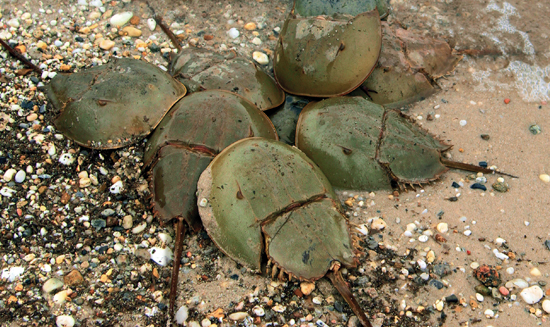



To download the bait recipe, visit the Delaware Sea Grant website: www.deseagrant.org
Eel and whelk don't typically feed on adult horseshoe crabs in their natural environment, yet find them hard to resist in baited pots.
That disconnect intrigued Nancy Targett, director of Delaware Sea Grant, dean of UD's College of Earth, Ocean, and Environment and an ecologist who studies the chemical cues that influence animal behavior in the sea. She and her research team set out to identify the mysterious "scent" that lures in eels—and after years of research, came up with a bait alternative to horseshoe crabs.
Delaware Bay is the epicenter of the world's horseshoe crab population, but the animal's numbers have declined in recent decades. That downturn has been linked to the decline of the red knot, a shorebird that relies on horseshoe crab eggs to fuel its spring migration north.
To reach the goal of finding an alternative bait, Targett partnered with DuPont scientists to analyze the horseshoe crab's chemical makeup. They identified 100 compounds in tissue samples and were able to rule out some as key components in the scent that appeals so strongly to eel and whelk.
Concurrent with the chemical approach, Targett's lab developed artificial bait made from alginates (compounds found in brown seaweeds and kelp), a small amount of coarsely ground horseshoe crab and food-grade chemicals including baking soda and citric acid. When mixed together, these ingredients form a quick-set gelatin.
Compared with using half of a female horseshoe crab, which is the Delaware limit, the mixture was just as productive in catching eel using only one-eighth of a female. By substituting an invasive species, the Asian shore crab, the researchers cut that amount down to as little as one-sixteenth of a horseshoe crab. They tested catching whelk with the bait and found similarly successful results.
In addition, despite speculation that female horseshoe crabs were better baits than males, the scientists found that artificial baits composed of males or females were equally effective. The Delaware limit is one whole male per trap or pot.
LaMonica Fine Foods in Millville, N.J., has started producing the bait commercially. Field tests in Delaware Bay with local whelk fishermen have been successful so far.
"The hallmark of this bait is that everyone wins," says Jim Roussos of LaMonica
Fine Foods LLC. "This is a major step in conserving the natural resource of horseshoe crabs. The conch and eel fishermen are relieved of the pressures of buying, storing and processing horseshoe crabs. The University of Delaware has proven once again that it is a vital, important and valuable institution not only to its students but to the public at large. And commercial fisheries win when we can be conservators of public resources while maintaining our historical way of life."
The research was funded by Delaware Sea Grant, the Delaware Department of Natural Resources and Environmental Control, and DuPont Chemicals and Fluoroproducts.